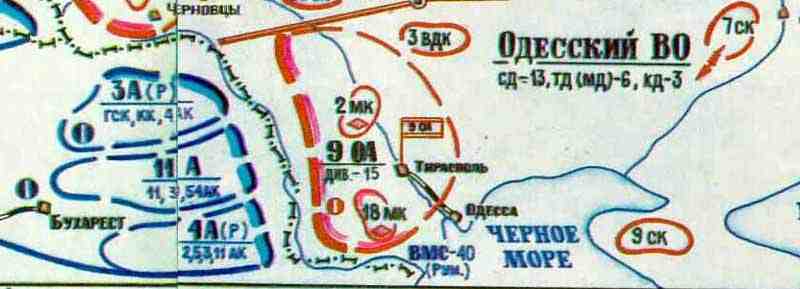
Southwest
direction
Strategic
expansion on the Southwest direction.

On
the Southwest direction the group of armies "South", was resisted by
forces of Southwest and South Fronts. The Soviet grouping on
the Southwest direction was strongest on all front, because the impact on Kiev was considered as the main impact of the
Red Army. However
here again Soviet forces have not finished a concentration and expansion. So, in
Kiev military district in immediate proximity from borders was only 16
Soviet divisions, and
14 settled down in 50-100 kms from it. The promotion to the border forces of
31st (193rd, 195th, 200th RD), 36th (140th, 146th, 228th RD), 37th (80th, 139th,
141st RD), 49th (190th, 198th, 109th RD) and 55th (130th, 169th, 189th RD) Rifle
Corps began from middle of June.
Strategic
expansion on the South direction.

In Odesa military district in 50-km front line was nine Soviet divisions, and six settled down in 50-100 kms behind a border. Besides on territory of districts the forces of 16th and 19th Soviet Armies arrived, from which structure by June 22 has concentrated 10 divisions (7 rifle, 2 tank and 1 motorize), aggregate number 129675 men, 1505 guns and mortars and 1071 tanks. At all not being completed on staffs of military time, the Soviet armies surpassed German group, however they have not finished a concentration and expansion
| "Kiev" and "Odessa" military district (Russia) | Group of armies "South" (German) | Ratio | |
| Divisions | 91,5 | 61,5 | 1,5:1 |
| Man | 1412136 | 1508500 | 1:1 |
| Guns and mortars | 26580 | 16008 | 1,7:1 |
| Tanks | 8069 | 1144 | 7:1 |
| Aircrafts | 4696 | 1829 | 2,6:1 |
The German armies had only some superiority in alive force, but considerably conceded
in tanks, planes and artillery.
The group of
armies "South" in structure
of three armies and one tank group in total twenty six field,
four motorize, four mountain and five tank divisions, put impact by mobile forces in
Kiev direction with a task to destroy Russian forces in Galitsiya and the West Ukraine to the west of
Dnieper river and take
possession of ferries through the Dnieper river in Kiev area. This group of armies was
supported by 4th Air Fleet.
At
the Prut river together with the Romanian formations 11-th German army was
unwrapped. In the beginning it had a task only defence character: to protect the vital territory of
Romania. Only during the further development of events 11th Army should pass in
offensive with the purpose to prevent the organized withdrawal of Russian forces, resisting to
it.
The Shock group on the left wing included
6th and 17th Armies together with 1st Panzer Group in structure of five tank and four motorize divisions. Between Peremyshl and
Tomashuv, in mountain
area, to which the new Russian border lasting up to the
crest of Carpathians to the southwest of Chernovtsy 17th German
army was unwrapped. It should break through a frontier
defense, reject by the strong left flank the Soviet forces , facing to it, on
the southeast and, using success of 1st Panzer Group, it is duly to reach Vinnitsa
area from the north. Then 17th Army should continue offensive to the east or to
the southeast depending on conditions.
6th German Army was to the north
of 17th Army in
readiness of offensive to break through a defense by both sides of Lutsk.
Covering the north wing of group of armies against probable impacts of
the Soviet forces from Pripyatsk bogs area, it should break as it
is possible by the large forces on Gitomer.
Between both
armies the 1st Panzer Group was
located. It has received a task in interaction with two armies to break
through Russian positions between Rava-Russian and Kovel, and then
through Berdichev and Gitomer reach the Dnieper river in area of
Kiev. German command hoped, that 1st Panzer Group
can therefrom advance further on the southeast, that by impact in rear of the
Soviet forces block a withdrawal through the Dnieper river.
In
Bessarabiya there were eleven rifle, one cavalry,
two tank division and seven motor-mechanized brigades, which on wide front
covered Soviet border at the Prut river and in depth dispose up
to opposite bank of the Dnestr river. In area between Chernovitsk and Pripyatsk bogs
behind the border were basic Soviet forces up to twenty seven rifle, seventeen
cavalry, three tank divisions and four
motor-mechanized brigades. Behind them were unwrapped twelve shooting
and three cavalry divisions one tank division and
three motor-mechanized brigades. Therefore group of armies "South" has met
here powerful defense.
Though
the Soviet forces have incurred heavy losses, but have left from Germans
encirclement and have removed forces behind the Sluch,
West Bug and Dniester rivers.
Kiev defence operation (July 7 - September 26)
September 26, the battle was finished. Germans
informed that capture in captivity 665 thousand Russian soldiers.
Summy-Kharkov' defense operation
October 5, 1st Panzer Division SS has left to the Azov sea in Berdyansk. There was encirclement near Chernigovka. In a result of this battle the Soviet 18th Army was destroyed.
Taganrog was fall on October 12. On October 28, Germans came to the Mius river- the last barrier before Rostov.
November 29, Rostov-Don was released and German 1st Panzer Army was broken.
[ on main page ]